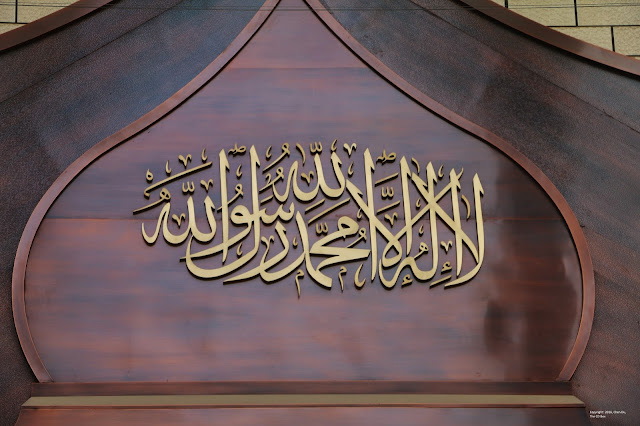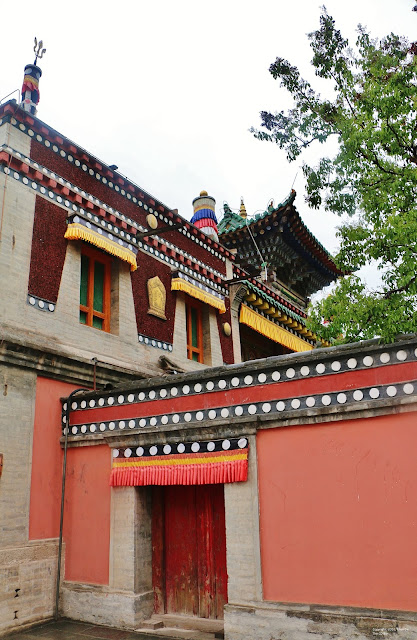Xining - China's Religious Heartland
One thing that puzzled me was that while on the train moving fast towards China’s vast western inland, all sorts of religious buildings passed by like stars in the sky. It was very surprised to see these sights in China, a self-proclaimed atheist, Communist state whom the western media has often labeled as a “persecutor of religion” and a nation that frequently “violates religious and other human rights”. While I believe that there is a reason why the West would make such claims, but the situation (at least for now) seemed to be improving for those who practice faith.
When the train entered Qinghai province, I was blown away by what I saw.
Tibetan and Chinese Buddhist temples could be spotted literally in every village and town. The most shocking sites, are the skyline- dominating, giant mosques under construction - not just one, but maybe two or three simultaneously in the same neighborhood.
The capital city of Qinghai is Xining. It is the largest city on the Tibetan Plateau and the starting point of the famous Qinghai – Tibet Railway. Xining is a crossroad city where many ethnic groups have lived together for thousands of years. Some of the famous people from Xining in the past one hundred years alone include the Hui Muslim warlord Ma Bufang, His Holiness the 10th Panchen Lama (Xunhua Salar Autonomous County), and the Nobel Peace Prize Laureate His Holiness the 14th Dalai Lama (Ping’an District, part of Xining at the time of his birth).
Among the city’s many religious groups, Islam is the largest in terms of followers and has the most influence on the city’s cultural landscape. The vast majority of practitioners of Islam in Xining are the ethnic Hui people, who account over 30% of the city’s population. Other ethnic minorities who practice Islam around the Xining area are the Turkic Salar people, a small population of Mongols, and the Kazakhs.
For every great city, there is always a landmark that symbolizes it. Like Paris, Xining has its own Eiffel Tower: The Dongguan Great Mosque. It is one of the largest mosques in People’s Republic of China. At one time around 250,000 people attended the same worship session at the same time (Not everyone was inside the mosque though, many were on the streets)! To promote the Hui ethnic culture and the religion of Islam itself, the Dongguan Mosque has recently dropped the requirement to pay admission to visit the site. There are free tours conducted in Chinese, Arabic, and English by the local people, but don’t forget to make a small donation if you really appreciate what you see or learn.
While the Dongguan Great Mosque is the epitome of mosques in Xining and is open to tourists for educational purposes, there are other mosques where people can visit for a more authentic experience. The Nanguan Mosque, a Moorish style mosque slightly smaller than Dongguan, is located just a few blocks away but is rarely visited by travelers. The mosque also comes with a playground, a school, and an office, but access to the main worship hall is restricted only for Muslims. Around Xining there are also other mosques built in the traditional Chinese style. These mosques are much smaller and are often located in some of the small alleys in the traditional Hui neighborhoods.
Speaking about one of the greatest contributions of the Hui community, almost everybody agrees that the local cuisine would never be the same without the Huis. The food in Xining is the mixture of Northwestern Chinese, Central Asian, and Tibetan cuisines, due to the city’s geographical location as a crossroad for all these regions. The ingredients for many of Xining’s signature dishes, such as barley, mutton, and yak, are all from the nearby area as well as other places within the province of Qinghai. Because of the city’s strong Islamic influence, in Xining, you will find most of the food halal – yes,that includes a couple of KFCs in the city center area.
The second most influential religion in Xining, which is also the most influential religion in the province of Qinghai, is Tibetan Buddhism. Tsongkapa, the founder of the Gelug pa school of Tibetan Buddhism (The Yellow Hat Sect), was born in Xining’s Huang Zhong County. Both the current Dalai Lama and the previous Panchen Lama, who are considered as two of the most important monks in the Gelug pa school, were born near Xining and educated in Huang Zhong County’s Kumbum Monastery (Ta’er Monastery). Legend suggests that Tsongkapa himself was born on the site of today’s Kumbum Monastery.
Kumbum Monastery is one of the largest and the most important Tibetan Buddhist Monasteries outside of the Tibetan Autonomous Region (TAR). As a result, many pilgrims from all over the world making journeys over thousands of kilometers to Xining, which also include many who traveled all these miles on foot. Traditionally Tibetan Buddhism is practiced by people not only on the Tibetan Plateau, but also many ethnic groups in China like the Mongols and those in countries like Russia, Mongolia, India, Nepal, and Bhutan. Being a monastery that’s not located within the boundaries of the TAR, everyone, both domestic and foreign visitors could easily learn about authentic Tibetan Buddhism without the hassles of special permits.
Kumbum Monastery is renowned for is its second to none butter statue craftsmanship. Butter statues are made with yak butter every year during important dates and events. The statues have different colors and you can barely tell that some of the very complex ones are in fact made of butter the first time you see them!
Yak butter is also used for making the world famous Tibetan butter tea. The area immediate to the Kumbum Monastery is a traditional Tibetan community. You can find several Tibetan restaurants in the area. When I visited the Kumbum Monastery, I decided that I must at least have some Tibetan food before I leave, or otherwise the trip itself wouldn’t be complete. Later I found myself in one of the back streets, where seemed to be a little bit of a run-down. I entered a very small restaurants where the customers were mostly monks – I was sure they knew where the good ones were. I ordered some Amdo style momo, lamb soup, and a flask of butter tea. I’d say overall the food is the same, if not better than the ones in Tibet Autonomous Region. However the service I received certainly beat any restaurants in the west that expect their customers to pay tips!
I remember that when I was in Tibet Autonomous Region, the people there talked about how Huis and Tibetans had been dependent on each other for hundreds and even thousands of years. Because the vast majority of Tibetans are Buddhists, they cannot perform tasks such as butchering. Yet Tibet is a place where the air is thin and vegetables don’t grow, and the residents there must rely on meat to obtain necessary nutritions and energies. Huis, who are Muslims, are very good businessmen specializing in butchering, food making, and transportation. As a result, most of the yak meat you eat in Tibet or most of the meat you eat at a Tibetan Restaurant, are in fact halal meat (some Tibetans also eat pork, which mostly came from Han butchers and packaged food made elsewhere in China). In the end, both groups left behind the differences, but received the full benefits of interacting with each other. I believe that if the Muslims and the Buddhists in Tibet can co-operate and live together for thousands of years at peace, then every single religious group should be able to live at peace for thousands of years to come.
Besides Islam and Tibetan Buddhism, Xining is also home to many other religious groups. The Tulou Temple just outside of the city is a classic example of a Daoist monastery. Near Dashizi in the city center, a cathedral stood right across the street from the Panchen Lama’s office in the Qinghai.
Being a crossroad city since its beginning, Xining continues the tradition of hosting people of different faiths and culture. Today, it carries on the torch as the leading religious city in a country that openly advocates for atheism. At the same time, it also shows that instead of forbidding and tightening its grip over religions, China is investing and encouraging its citizens (with some exceptions to certain social, political, and ethnic groups) to learn and practice faiths. I know the past definitely wasn’t smooth, especially during the Cultural Revolution for all religious groups, but the present situation is certainly a giant improvement, and I can tell that the future is even more promising.
 |
| Xining City Center And The Huang River |
Tibetan and Chinese Buddhist temples could be spotted literally in every village and town. The most shocking sites, are the skyline- dominating, giant mosques under construction - not just one, but maybe two or three simultaneously in the same neighborhood.
 |
| The Construction of Giant Mosques near Ping'an District |
 |
| Xining City Center And The Huang River |
 |
| The Scripture Indicating The Name of The Great Prophet of Islam |
 |
| Hui Residents In Xining |
 |
| A Local Shopping Mall Specializing in Ethnic and Religious Clothing |
 |
| A Monument in Xining "Islam Follows Peace" |
 |
| The Great Dongguan Mosque |
 |
| The Great Dongguan Mosque |
 |
| The Prayer Hall |
 |
| The Great Dongguan Mosque |
 |
| The Cleansing Room: An Islamic Tradition that all Muslims must thoroughly clean their bodies before the worship |
 |
| The Nanguan Mosque |
 |
| A Moorish Style Office Building At The Nanguan Mosque |
 |
| A Traditional Chinese Style Mosque |
 |
| The Ancient Baiyu Mosque In A Back Alley |
 |
| A Local Hui Food Market |
 |
| Yogurt Made of Yak Milk - A Qinghai Specialty |
 |
| The Interior of a Halal Deco's Fast Food Restaurant in Xining |
 |
| The Statue of Tsongkapa Covered In Snow |
 |
| Seven Stupa - The Symbol of Kumbum Monastery |
 |
| A Traditional Amdo Tibetan Building Inside the Monastery |
 |
| The Kumbum Monastery |
 |
| One of the chapels at the Kumbum Monastery |
 |
| A Monk at the Kumbum Monastery |
 |
| The Main Prayer Hall at the Kumbum Monastery |
 |
| A Butter Statue |
 |
| The Library |
 |
| Prayer Wheels |
 |
| A Pilgrim |
 |
| A Cat At 10th Panchen Lama's Resident Inside The Monastery |
 |
| The Back Alley Where I Searched For Food |
 |
| Amdo Style Momo, Lamb Soup, and Butter Tea |
 |
| Two Monks At The Kumbum Monastery |
 |
| A Halal Butcher Shop In Xining |
 |
| A Christian Church In Xining's City Center |




Comments
Post a Comment